Back
Jul. 27 2018 Miscellaneous By ___
If you have an ATV or UTV, you probably want to take it all over the place to find the best dunes and trails out there. Trailers are a great way to transport your four wheeler, since they're lower than most truck beds and they prevent the extra wear and tear on your vehicle. However, with driving a trailer comes a few more responsibilities and guidelines. Driving with a trailer is much different from everyday driving, and if you've never driven with a trailer before, you should anticipate the difficulties that will arise when you're out on the road. Harold Implement Company has put together this list of guidelines, and these can help both first time towers and experienced haulers. If you have any other questions about towing safety, we're happy to help you.
We proudly serve Paragould, Jonesboro, and Pocahontas, Arkansas, as well as Poplar Bluff, Missouri.
Before getting out on the road and towing your ATV or UTV, you should know what kind of trailer will work best to haul your Four Wheeler. You should know right away if you need an open or enclosed trailer, how many axles you have, and whether or not you've got brakes on one axle. A single axle is good for just one or two four wheelers, and it usually makes for a bouncy ride, but you can get there just fine if you keep the weight down. Dual axles should be used for larger loads, and create a smoother ride. Brakes included on the trailer's axle make braking much easier, so if you're new to towing, it's not a bad idea to get a trailer with its own brakes.
Before loading your ATV into the trailer, check your level to ensure it's ready to hook up to the truck. You might be able to tell if it's level just by looking at it, but to be sure, measuring the front and back with a tape measure is a more sure fire way to check accurately.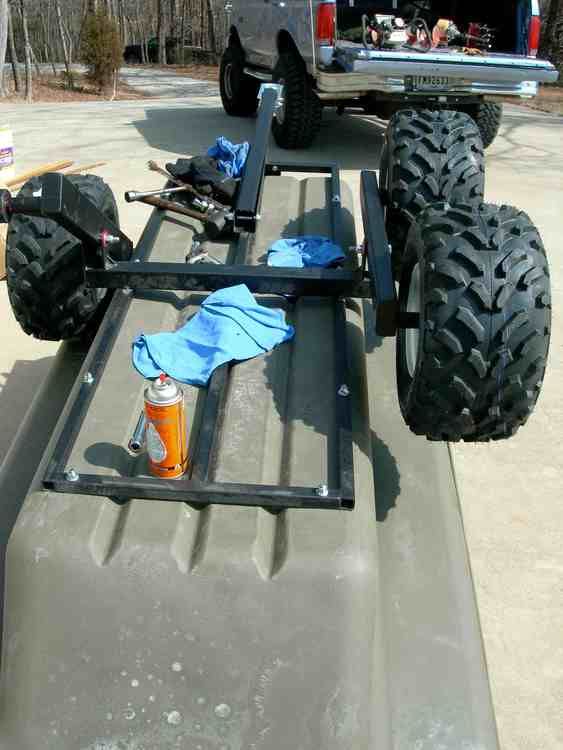 Once your trailer's level, measure the height of the hitch and adjust your truck's draw bar to match up. Then, just drop the trailer onto the ball hitch and you're set to finish hooking up!
Once your trailer's level, measure the height of the hitch and adjust your truck's draw bar to match up. Then, just drop the trailer onto the ball hitch and you're set to finish hooking up!
Set your safety chains in an X formation beneath the hitch. This prevents your chains from binding while you turn, and the X pattern will prevent your trailer from disconnecting for your truck. With newer trucks, it's a good idea check your brake and turn signals after you hook into the electrical wiring harness. Lastly, after everything's secure, lock the latch and insert the safety pin before using the jack.
Once you're hooked up and ready to load, switch your four wheeler to four wheel drive and and gently drive your UTV or ATV into the trailer. If you're loading more than one four wheeler, you should maneuver each one so that they balance over the axles. This is important for load distribution, as too much wait in the front or rear can really affect your trailer's driveability. Lastly, you can tie down your four wheeler's with ratchet straps, which you can use in a way that compresses the suspension so it doesn't bounce while on the road.
Lastly, you can tie down your four wheeler's with ratchet straps, which you can use in a way that compresses the suspension so it doesn't bounce while on the road.
Now that you're all prepared, it's time to hit the road! Anyone can drive with a trailer, so you can too as long as you follow basic trailer safety principles. Brakes on a trailer work differently, so allow plenty of following distance. This will allow you time to stop if the car in front of you slams on their brakes. Also, take corners much slower than you would in a car or truck, since your center of gravity is now much further behind you. Overall, though, just take your time, and give yourself some practice to get used to the different handling and braking methods when hauling a trailer.
If you follow these tips for hauling your ATV or UTV, you'll be just fine on the road, and you'll get your four wheeler to the all the best trail riding spots you can think of. Most of the important steps are in the preparation for driving with a trailer, so make sure you follow all of these steps carefully before you get out on the road. With any other questions, stop by sometime and see us at Harold Implement Company. We've been doing this for awhile, so we know what you need to be successful when towing your four wheeler.
With any other questions, stop by sometime and see us at Harold Implement Company. We've been doing this for awhile, so we know what you need to be successful when towing your four wheeler.
See All Posts
The trailer needs to be proper attached to the car before loading the UTV on to the trailer.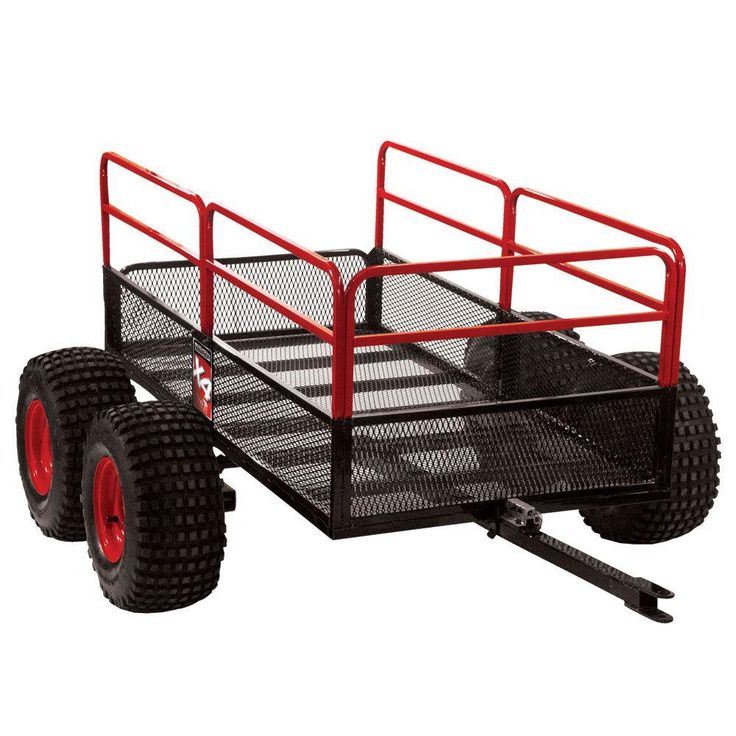 The cars parking brake should be engaged. Use loading ramps and drive carefully up on the trailer. Make sure to put the straps thru solid places like the frame. Do not put straps around the suspension or drive axels due to the risk of damaging the vehicle.
The cars parking brake should be engaged. Use loading ramps and drive carefully up on the trailer. Make sure to put the straps thru solid places like the frame. Do not put straps around the suspension or drive axels due to the risk of damaging the vehicle.
Different UTV users have different ways of getting their vehicles from one place to another. However, it seems that most of the side-by-sides you see transported on the highways and streets are mounted onto a trailer. Using a trailer for UTV transportation is probably the most convenient and least expensive way of getting your UTV from your home to your riding spot.
But, before you get on the road, UTV needs to be loaded and properly secured. Although this seems like a simple task at first glance, loading your ride has to be handled with utmost attention and care. This is important due to your own safety and, also, for the protection of your investment. While you drive to your desired destination, it’s more than likely that you will face road bumps and unpredicted traffic situations. If your side-by-side is not secured in the right way, it may be seriously damaged. And, as we all know, UTV’s are not exactly the cheapest toys out there.
If your side-by-side is not secured in the right way, it may be seriously damaged. And, as we all know, UTV’s are not exactly the cheapest toys out there.
Table of Contents
Plenty of newer UTV models are too large to be mounted on pickup trucks so the trailer is probably the best solution for their transport. Choosing the right trailer can make all the difference when it comes to the vehicle’s security and the ease of loading. Of course if you don’t need to transport your SxS that often, renting a trailer is also an option.
Take into account the dimensions and weight of your UTV when shopping for a trailer. The weight of the vehicle plays the biggest role when deciding between a single or double axle trailer. Tandem axle designs can handle more weight and are sturdier and stable, but single axle ones are significantly cheaper and can do just fine if you own one of the smaller UTV models. This also plays a part in properly placing a vehicle on the trailer’s surface. Another factor that plays here is that many people travel with more than one UTV or haul an ATV also.
Another factor that plays here is that many people travel with more than one UTV or haul an ATV also.
On the other hand, the overall dimensions of your four-wheeler will influence whether you get the enclosed or open trailer. Enclosed models will provide better protection from natural elements and road debris, but you may have some trouble loading and fitting larger vehicles into them.
It’s a good idea to get a trailer with a built-in easy-access ramp gate. There are plenty of available models on the market. This will make the loading easier and you won’t need to drag the loading ramps everywhere you go.
If you don’t own a trailer that has one built-in, then you’ll also need to acquire a loading ramp. The main factor to be aware of when deciding on a ramp is your UTV’s weight. Make sure you get a heavy-duty ramp that can fully support the wet weight of the vehicle. Pay attention that the ramp you end up with can be attached to your trailer. Depending on the trailer’s height and width, you can go with a single ramp or a dual runner, If you’re short on storage space, look into one of the foldable models.
Before loading a vehicle, there are a couple of things you need to check on. First of all, make sure you’re on a flat and even surface and keep the vehicle and trailer as level as possible. If one of the tires is not touching the ground, do not load the UTV and find the surface with no grade. The towing vehicle parking brake should be engaged.
Then connect the trailer tongue to a tow vehicle hitch. Hook up safety chains and wires and verify that they are secure and properly connected. Under the tongue, cross the safety chains in an “X” formation. Prior to loading, test electrical connections, and brake harness. this is much easier to do with an empty trailer.
The majority of riders don’t do this when loading up but put on a helmet. You will be driving a short distance at an extremely slow speed, but accidents still can happen and at least you want your head protected. Better safe than sorry.
After all the preparation, you’re ready to load up your UTV on a trailer.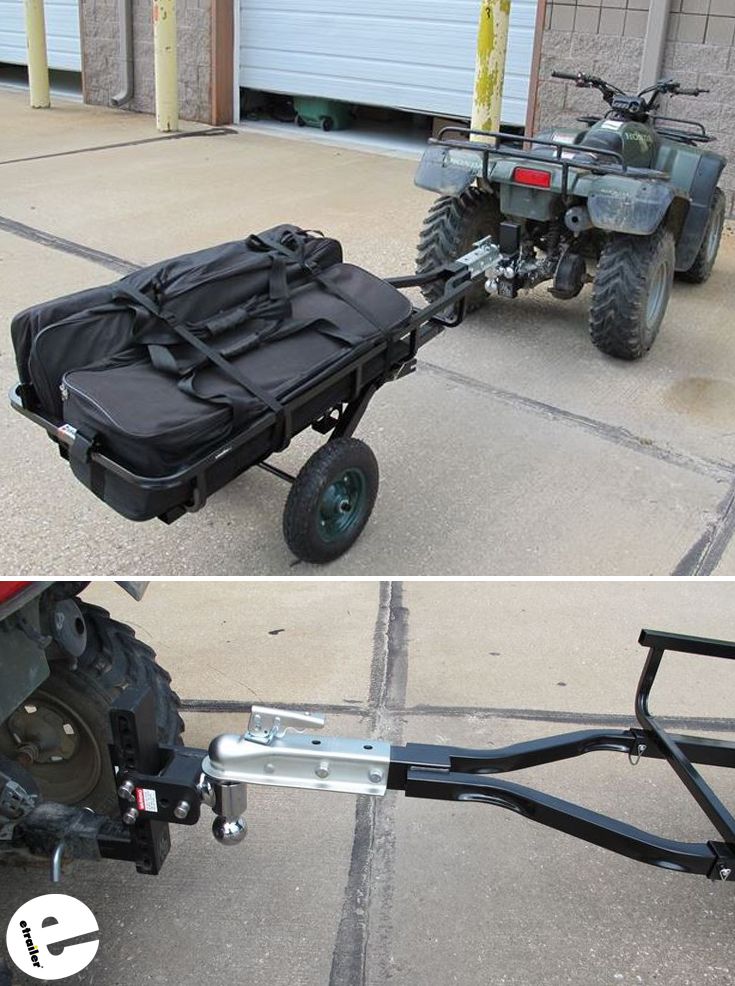 Line up the wheels of your side-by-side dead straight with the towing vehicle’s center. Place the UTV in the lowest possible gear and activate four-wheel-drive mode if you have it. In this case slow and steady wins the race. You want low speed, but also more torque. This will also prevent the SxS from making sudden jerk movements in case you press the gas too much. Gently apply the gas and creep slowly up the ramp. Try to do this in one continuous movement and avoid stopping and starting. If you feel you’ve pushed the throttle too much, it’s best to back up to the flat ground and start over.
Line up the wheels of your side-by-side dead straight with the towing vehicle’s center. Place the UTV in the lowest possible gear and activate four-wheel-drive mode if you have it. In this case slow and steady wins the race. You want low speed, but also more torque. This will also prevent the SxS from making sudden jerk movements in case you press the gas too much. Gently apply the gas and creep slowly up the ramp. Try to do this in one continuous movement and avoid stopping and starting. If you feel you’ve pushed the throttle too much, it’s best to back up to the flat ground and start over.
When you crest over the ramp and reach the trailer’s deck, slowly move towards the front and gently brake to stop the UTV. Shut down the engine and put the vehicle in park and engage the parking brake. Depending on your UTVs type of transmission, some UTV users prefer to leave the vehicle in gear, but experience tells that this is a much safer option. Make sure not to forget to remove the key from the ignition.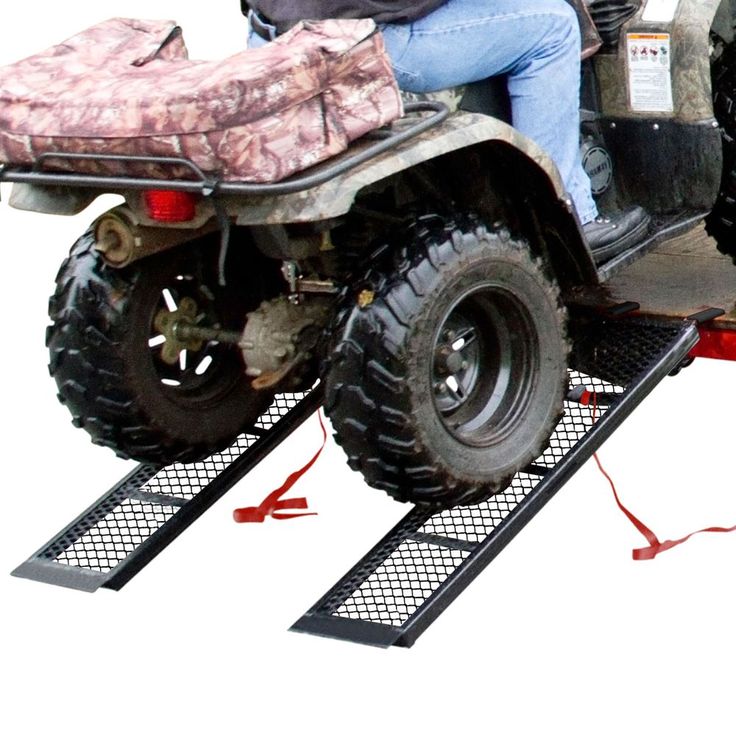
The placement of the UTV on the deck will depend on the trailer’s design but, in general, the weight should be distributed towards the front side. Parking closer to the rear may cause problems with handling while driving. Apply the “60/40” rule, meaning that roughly 60 percent of the weight should be in the front half.
Once your UTV is on the trailer, you need to secure it and make sure it stays safe in place for the duration of the transport. This can be achieved with several anchoring options. While some still use plain old chains and rope, now there are much more modern and safer options available.
The most common method of securing the UTV on a trailer is by using ratchet straps to anchor them to the deck. There is a variety of straps available on the market, ranging in price and quality. This is not where you should prefer budget options and think about saving money. Find quality straps that can withstand the weight of your side-by-side that are durable and can resist weather conditions.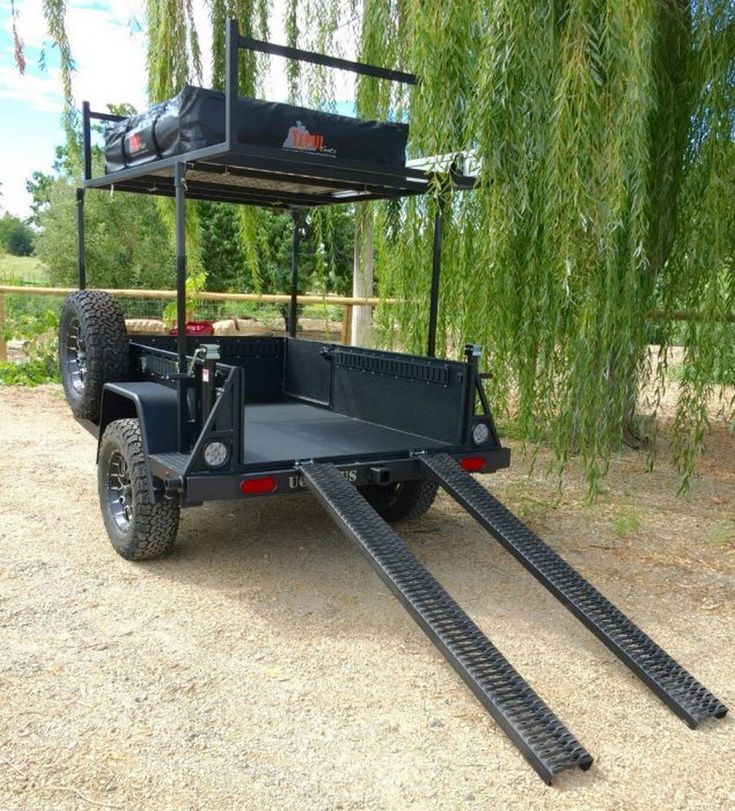
Although some people are using two straps to tie down their vehicle, the safer and recommended option is using four. One at the driver’s side in the front and one at the rear. The same goes for the passenger’s side. You need to identify the best tie-down attachment points on your UTV. The best points are at the frame of your vehicle because it’s the hardest and sturdiest part of the UTV. You can also use the front bumper if its firmly welded to the frame or the hitch for back straps. Always try to look for the lowest possible points of attachment. Straps should be set at an angle sharper than 45 degrees. Avoid strapping to the suspension or axles because it can cause damage to your vehicle. Also, check if strap goes over any sharp edges because in time it will wear down and break.
After you’ve attached straps to the vehicle, you need to anchor them to the deck. Once the strap is hooked up to the frame, roll out the other end to a tie-down spot on the trailer and tighten it using the ratchet. Do this for all four straps. You should anchor the straps to the furthermore points on the trailer. When you finish, inspect the straps to see if they are properly tightened.
Do this for all four straps. You should anchor the straps to the furthermore points on the trailer. When you finish, inspect the straps to see if they are properly tightened.
Using this method compresses the suspension to some point. The lower attachment points on the vehicle are, the suspension will be less compressed and it will allow your UTV to bounce a little bit. Although the compressed suspension is not necessarily a bad thing. After all, the manufacturers themselves ship the vehicles this way.
Another popular method is using tire bonnets or wheel baskets. These are specifically arranged straps that go over each wheel creating sort of a basket for the tire. They are secured to the deck behind the wheel. The downside of this method is that bonnets must have tie-down points directly behind and in front of the wheels. Although very safe, this system needs to be very precise and can be somewhat complicated and time-consuming. Also not every trailer is compatible with this anchoring approach.
You can also use a wheel chock to hold your UTV in place. It’s the system that employs plates that you bolt down to your deck and use to align tires between them and then strap the wheels with webbing wraps. The metal brackets on each wheel prevent them from moving. These straps are usually adjustable and can be used on a number of types and sizes of tires. Some UTV owners use more traditional chocks without the straps.
ATVs are designed for driving on difficult tracks. On their own, they are not able to move along the highway for long distances, because the quadra has a large suspension travel. If you plan to ride away from home, the first thing you need to decide is how to transport the quad bike to the ride location. There are several ways to transport motorcycles. Each of them has its own advantages and disadvantages. When choosing the best option, it is important to consider the distance between the start and end points.
If you need to transport the ATV over a short distance, you can use a private car or use the services of a transport company. But sometimes you have to transport equipment hundreds of kilometers away. In such cases, ATV owners are more likely to opt for the services of professional carriers. It is risky and dangerous to transport bulky cargo on your own.
Transporting an ATV with a trailer is the best option for those who need to transport equipment over any distance. This is a universal solution that allows you to conveniently transport children's, utility, sports ATVs. But keep in mind that not every trailer will fit. It should be a full-fledged loading platform that allows you to securely fasten the vehicle. The maximum speed of a car with a trailer is 70 km/year, in a built-up area – 60 km/year.
A trailer for transporting an ATV can be made by hand or purchased ready-made.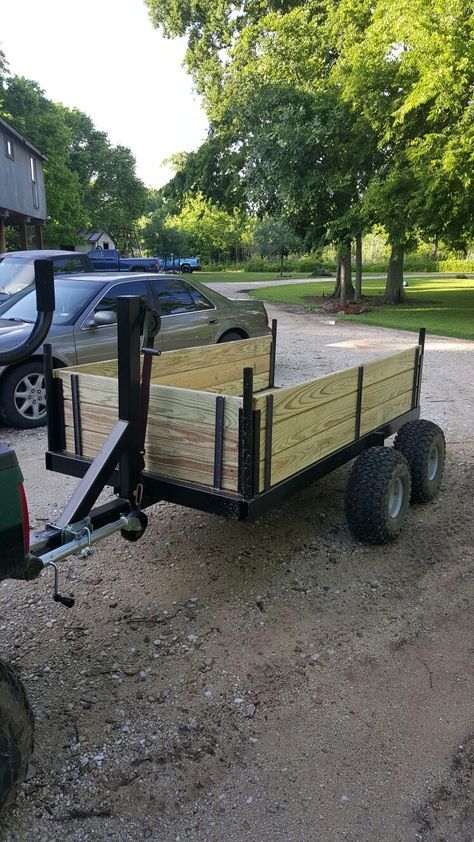 There are craftsmen who independently make platforms for transporting two ATVs. The work is quite difficult. It is necessary to prepare drawings, sketches, purchase materials. In addition, a homemade trailer must be registered. This will also have to be dealt with.
There are craftsmen who independently make platforms for transporting two ATVs. The work is quite difficult. It is necessary to prepare drawings, sketches, purchase materials. In addition, a homemade trailer must be registered. This will also have to be dealt with.
It is much easier and faster to buy a ready-made trailer. For the transportation of ATVs, platforms of different types are used.
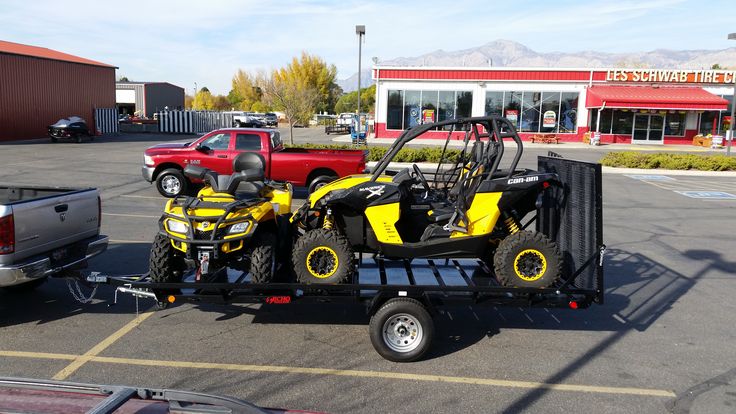
When choosing a trailer, consider the distance over which you will need to transport equipment, the design features of the ATV, as well as your financial capabilities.
To transport a vehicle from one place to another on a trailer, you first need to secure the ATV. Driving safety depends on this. Fixation with belts for wheels, the seat is not reliable. For proper fastening, you will need two ratchet straps. The work should be done in the following sequence:
This method is reliable and convenient, allows you to carefully drive an ATV for any distance. Such fixation will not harm the winch or the seat. The wheels do not slip, motor vehicles do not shake the trailer while driving. If the ATV is not fixed or fixed incorrectly, this can lead to a deterioration in its performance, damage to important components and mechanisms.
If the ATV is not fixed or fixed incorrectly, this can lead to a deterioration in its performance, damage to important components and mechanisms.
Do you have a private car? Why not use it to transport an ATV? A light model (sedan, station wagon, hatchback, etc.) is not suitable for this purpose, since the dimensions of the cargo are quite impressive. Motorcycles simply will not fit in the luggage compartment of such cars. You can transport ATVs in minibuses and pickups. First, the vehicle must be loaded, secured in the body, check the reliability of fixation.
There are plenty of companies in Russia that provide cargo transportation services. Transport firms, evacuation services, even private individuals – there is one to choose from. In certain cases, their services are beneficial to the client. ATVs are transported on tow trucks, semi-trucks and cargo vans. When seeking help from the evacuation service, certain nuances should be taken into account.
When seeking help from the evacuation service, certain nuances should be taken into account.
For one-time transportation over a short distance, a tow truck can be used. But if you have to transport vehicles hundreds of kilometers away, it is better to give preference to another method.
A very good solution is to contact a company that deals with cargo transportation. This option is relevant if you bought equipment in another city, and it makes no sense to drive a personal car after it. Such organizations have their own fleet of vehicles. The machine is selected depending on the dimensions of the ATV. For transportation of motor vehicles can be used:
The choice of a transport company also needs to be approached carefully. A reliable contractor is ready to take on all obligations related to the delivery of motorcycles. Such organizations operate under an agreement that specifies the terms of cooperation, prices, terms, responsibilities of the parties, etc.
Another advantage of using a transport company is turnkey work. Specialists work out routes in detail, select a platform for a specific model of motor vehicles, notify the user about the movement of cargo.
Specialists work out routes in detail, select a platform for a specific model of motor vehicles, notify the user about the movement of cargo.
No documents are required for the transportation of motorcycles in Russia. It is only important to prove that the ATV is yours. Take with you the contract of sale or donation for this. No insurance or license required. If you are importing a vehicle from abroad or exporting it outside the country, check if the ATV is equipped with license plates. A certificate of registration is also required.
So, we have considered the most common ways of transporting ATVs over short and long distances. For transportation of motorcycles, you can use:
The most rational solution is to use a trailer. If you don't have it, buy it. There are many great deals. This device is sure to come in handy in the household. With it, you can transport crops, building and finishing materials and, of course, motor vehicles.
If you don't have it, buy it. There are many great deals. This device is sure to come in handy in the household. With it, you can transport crops, building and finishing materials and, of course, motor vehicles.
ATV is designed for off-road and rough terrain. But, as a rule, to get to these cherished expanses, you have to overcome tens of kilometers along public roads. And in this case, the ATV must be transported either on a trailer or in the back of a pickup truck, because ATVs are not designed to drive on public roads.
Then another question arises: how to load an ATV onto a trailer? And just the same ladders (gangways, ramps) are designed to solve this problem. They are wide metal strips (sometimes they are plastic), which form a kind of bridge between the ground and the loading platform. All that remains for you is to drive along the ramps onto a trailer, into the back of a pickup truck or into a van.
It would seem that the design of the gangway is so simple that there is nothing to invent here. However, on the market you can find a wide variety of loading ramps, differing in types of performance and functionality.
Many manufacturers make trailers designed exclusively for transporting motorcycles. Such models are most often equipped with folding ladders for ATVs. In this case, the gangway has a well-thought-out system of fixation and installation / dismantling. Ladders are made of aluminum, and the design is a frame reinforced with transverse slats (reminiscent of a ladder).
For loading ATVs on a conventional trailer, pickup truck or van body, apperels are available separately. They are made according to the same principle as the accessories described above, with the only difference that individual gangways are not fixed “tightly”.
To save space when transporting ladders, they are foldable.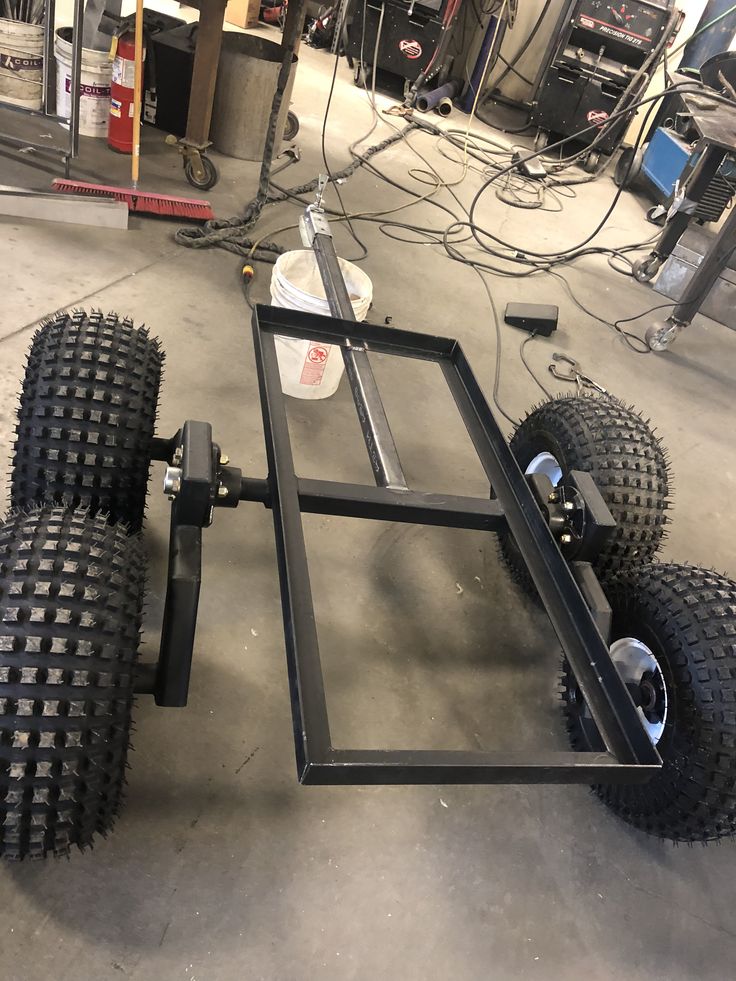 Moreover, they can be folded both across and along.
Moreover, they can be folded both across and along.
The next feature is the number of sections. The simplest ladders are two-section. Sections can be fastened together with aluminum strips. These ramps are suitable for loading UTVs or ATVs.
If you want to load your snowmobile into your vehicle, you will need a three-section gangway.
When buying a gangplank, two parameters must be taken into account: length and load capacity. As a rule, the length of the ramps ranges from 1 to 3 meters. A short gangway is also suitable for loading equipment on a low trailer, and for pickups and vans it is better to purchase models with a longer length.
With regard to load capacity, ladders can withstand from 350 to 900 kg. You need to choose a model in accordance with the weight of your ATV. Of course, it is better to take ladders with a margin in terms of carrying capacity.
An excellent option for loading an ATV onto a vehicle or trailer is the Moose fold-out two-section ramp.